What This Page Is and Isn’t
This page is not designed to cover all tips, techniques, needles sizes and such and cannot take the place of Kraft-tex books, videos, workshops, or project downloads. I show and discuss using an array of common art products on Kraft-tex, link to an ever-growing Pinterest board loaded with examples, include basic tips, and illuminate some basic starter information. That’s it.
Kraft-tex is a durable cloth-paper hybrid product and how you prepare it before using it can make a huge difference, something evident on my Kraft-tex Pinterest board.
What Does it Feel Like?
Right off the roll or bolt, it’s heavier than 140 lb. watercolor paper or cardstock but it doesn’t feel exactly like really heavyweight paper either. It’s a hybrid product initially created as a synthetic leather substitute, doesn’t need interfacing and basically you have two choices — make it supple like fabric/leather or keep it stiffer like really thick art paper.
The difference begins in preparation. Washing it makes it feel more like supple leather…more on that process in a moment. If you want to keep it paper-like, stiff, and flat, it can be ironed even on the highest setting. Some examples of projects that use flat unwashed Kraft-tex are folders, book covers, or envelopes. Also, using Kraft-tex with various templates meant for cardboard gift boxes, etc., is not an unknown. There are many free templates for this on the Internet.
The Official Kraft-tex Introduction: “Wait until you get your hands on this rugged paper that looks, feels, and wears like leather, but sews, cuts, and washes just like fabric. kraft•tex is supple, yet strong enough to use for projects that get tough wear. Use it to bring an exciting new texture to your craft-sewing projects, mixed-media arts, and bookmaking. Durable fiber-based texture softens and crinkles with handling and washing.” Source: http://www.ctpub.com/kraft-tex
Tips
Why tips? Because it’s a hybrid product, it’s a bit mysterious at first but Kraft-tex can offer frugality, artistic freedom, and the ability to make custom projects for your digital dohickies, kitchen stuff, car kits, sewing room necessities, or different sets of tools. Basic Kraft-tex tips can encourage crafters/artists and fire up some unimpeded excitement with up front initial information, as opposed to eking what they need to know out of numerous web pages, videos, and books. Without somebasic tips and does-this-work-with-that information, which is what this page is largely about, the learning curve can be too drawn out and frustrating some. (Kraft-tex projects, workshops, or patterns available for purchase out there will still have their place/value, I’m sure.)
Tip: Watch Out for Lint, Be Careful of What You’re Wearing — Often, artists don’t realize that their clothes shed fibers until they’re working in the studio. For example, wearing my fluffy navy blue bathrobe while working on white Kraft-tex left it covered with dark fibers.
Tip: All needles and Kraft-tex are permanent. all needle holes are permanent on Kraft-tex. This will affect what size needles you choose, how you backstitch, how you double stitch, and stitch length. Choose a longer sitch length than usual. You may use hand sewing needles, embroidery needles, or an 80/12 sharp sewing machine needle. You will not pin your pattern pieces together before sewing, for obvious reasons, you may have to clip them in places instead. One can also play with decorative perforation.
Tip: Needle sizes and scissor sharpening? Use a hand, sewing machine, or embroidery needle that’s strong enough but no larger. Also, Kraft-tex dulls scissors and sewing machine needles more rapidly so sharpen your scissors frequently enough and replace sewing machine needles if they get too dull. If you really get into Kraft-tex, you may want to use dedicated sewing machine needles (meaning you don’t use those needles for other stuff).
Tip: Do decorative stitching before you sew your project.
Tip: One can dye it an array of colors using Rit dye.
Tip: One can emboss Kraft-tex. Example: https://youtu.be/eUDQeFs117I
Tip: Cut our pattern pieces before pre-washing, if you’re pre-washing your Kraft-tex.
Tip: To fold, lightly score and then fold with the bone folder. This will make sure it folds along the intended line nice and neat instead of creasing and creating an imprecise messy fold. You can see the process here.
- To score, lightly draw the “blade” edge of a bone folder down along the intended line, then fold by running the flat side of your bone folder along the intended folding line.
- If you don’t have a bone folder, the rounded handle of a clean butter knife may be substituted.
- If you don’t have a bone folder, draw the blunt blade of the butter knife down the line where you want to fold, then carefully fold over with the blunt butter knife handle.
Tip: Test products you’re using on a scrap piece as you go.
Tip: It can be sewn using your sewing machine, with a heavy-duty sewing machine needle, just keep in mind that all holes from pins and needles are permanent. Therefore, backstitch slightly to the side to secure stitching — don’t go back-and-forth over the same stitching line as you normally would when backstitching or you’ll create a hole. For the same reason, if you want to double stitch, avoid double stitching over the exact same line but stitch slightly to the side of the first stitching line instead.
- Resource on how to choose the right sewing machine needle: http://www.joann.com/on/demandware.static/Sites-JoAnn-Site/Sites-joann-project-catalog/-/images/hi-res/project/pdf/PA00223.pdf
Your Basic Preparation Options
To Keep it Like Paper — Don’t Wash It — If you want to keep it stiff and flat like paper or cardstock, then don’t wash it before using Kraft-tex. It wipes clean pretty well as it’s water resistant. Unwashed, it could be used as a fine art surface (avoid creasing it then) or to make wallets, book covers, boxes, bag straps, etc.
Testing it as a fine art surface, It was placed either on a huge clip board or on my magnetic board. (I have a huge magnetic board and plastic/enamel-coatef super magnets so that I can work on Kraft-tex at my standing easel). So far, no tape that I’ve used to secure it to the clipboard has ripped or otherwise damaged the Kraft-tex. Whether different tapes can leave an undesirable tackiness or residue is possibly an issue with some techniques and/or art products? If in doubt, test first.

To Use it Both like Kind of Like Paper and Very Much Like a Fabric — Wash It — If you want to use it like a paper-cloth or a replacement for leather, then wash it before sewing it. If you wash it after creating your item, its resulting texture may not be as even. If you want to create a very soft fine leather-like texture, specifically, then use my method, below. This video discusses a different wash-and-crumple method than the following steps, and you can see it produced a faux leather texture that’s not as soft. A lot of people simply wash and dry their Kraft-tex on hot three times.
- Cut — Cut out enough for your project or cut out the pattern pieces in advance, in the first place.
- Container — Find a basin or cooking container that will hold your material. Remember, it’ll be kind of stiff when it first goes in to soak.
- Boiling Water Soak — Boil enough water, put it in your container, keeping all safety precautions in mind, and soak your Kraft-tex in that water for 5 minutes.
- Crumble It Up — Wearing protective, thick rubber gloves and using tongs, remove your Kraft-tex and crumble it into a ball, trying to crumble it as evenly as possible into a ball. Let it sit several minutes.
- Flatten — Lay it flat.
- Repeat — Now do steps 3 through 5 two more times — you will soak it in boiling water 5 minutes, crumple it in a ball, and lay it flat — you will do all that three times total.
- Dryer — As a final step, you can put it in the dryer on any setting, yes, including the hottest. In fact, some prefer the hotest dryer setting as the last step in turning Kraft-tex into a supple, sewable paper-cloth state.
Art Products One Can Use on White Kraft-tex, and Some to Use on Black Kraft-tex
I’m testing an array of art products on white Kraft-tex. Paints, markers, and pens have to be truly opaque for you to see them on black Kraft-tex … unless you’re talking about irridescent Shiva Paintstiks or interference acrylic paints and powders because those can show well on black art papers and black Kraft-tex.
Opacity and Absorption Considerations
Test even products that say they’re opaque — they may be varying degrees of opacity from brand to brand, colors may vary in opacity by nature, and some marker “juice’ may soak into substrates and dissapear some or alot while others will do fine. So test the color range or the colors you’re going to use. Also, keep in mind that washability is a consideration for some uses but not others. Some products are not washable but that may or not be a consideration for your project for various reasons. For example, if I spray a sealant on what I did and then coat it with a quality acrylic medium, it may not be a problem for the type and amount of wear my finished project might see in its lifetime. If my item is going up on a wall and isn’t going to be around outside or laid on tabletops were people might spill their drinks or other fluids, it may not be a problem that what I drew or painted on is not washable or might ruin if exposed to moisture. It all depends. Know your products and think it through before you create your items or works of art.
- Watercolors and Watercolor Pencils — Trying these on the white Kraft-tex, I found out they can be used wet, in dry-brushing, and in the form of watercolor pencil. One can lift colors back off of Kraft-tex and you’ll have to mind which are your staining colors, just as you would on any watercolor surface that allows lifting (removing some color). I have not tried a wide variety of wet watercolor techniques on this surface. Dry watercolor pencils, especially the lighter colors may show up on black Kraft-tex, at least my Cretacolor AquaMonoliths sure did, but test your brand first if you really want to know.
- Modge Podge Fabric — Works but it’s not my favorite and compared to acrylic mat mediums, it looks plasticky and can easily look gloppy if you’re not careful.
- Ink Jet Print It — More information being sought on that at the moment.
- Water-soluble Oil Pastels — I tried both Caran d’Ache Neocolor II and Cretacolor AquaStics (which are generally more lightfast). Both brands work well on this surface and, like watercolor, can be lifted off. Both brands of water-soluble oil pastels have staining colors, just as artist grade watercolors do. Both can be fixed to Kraft-tex. Here’s how I did that.
- Apply your water-soluble oil pastels. Color, wet, blend, etc., just like you can with these products on other papers.
- Let dry.
- Krylon Workable Fixative — See manufacturer’s directions and then spray with Krylon Workable Fixative and let dry. Don’t spray until you saturate the surface. Just give it a decent layer.
- More Fixative — Spray two more layers of Krylon Workable Fixative, letting each application dry. Let the last layer dry completely. It wouldn’t hurt to let it dry for a couple of hours or overnight.
- Acrylic Matte Medium — Finally, brush a light coat of acrylic mat medium over your fixed water-soluble pastels. (Liquitex Matte Medium is more matte than Golden’s, in Kraft-tex.) Let dry.
- Why Three Layers of Krylon Workable Fixative? — If you try to get away with only one layer of Krylon Workable Fixative, expect colors to bleed (especially some of the blues and greens in both brands). They bleed less with two layers of Krylon Workable Fixative using this method. I didn’t see any bleeding with three layers of Krylon Workable Fixative using this method. Please test whatever you’re doing with water-soluble oil pastels, however.
- TAP (Transfer Artist Paper) — Follow manufacturer’s directions. Before using, consider if you’ll be using Kraft-tex like a stiff paper or like a supple fabric and pre-treat it accordingly, or not. E.g., the Be Peace Bag shown here.
- Graphite Pencils — I tried the HB pencil from my Cretacolor set so far. These work well on white Kraft-tex, you can smudge and blend them, but they do not erase from Kraft-tex, not even if you use several erasers. I have not tried all the B pencils and I have not tried all brands. As always, test first. If you make heavy marks, you’re not going to be able to erase completely. If you make like marks and erase with a regular eraser and then also a kneadable erasure, you may be able to remove most of your pencil work.
- Sketching Pencils (sanguine, dark brown, black and white) — These work well on white Kraft-tex, you can smudge and blend them, but they do not erase from Kraft-tex, not even if you use several erasers. I have not tried all the brands. As always, test first.
- Rubber Stamps — They work well on it. Of course some ink pads are better than others, same as on other surfaces. Some are archival and water-resistant, others are very much not.
- Neopaque (opaque fabric paint) — Works well on different colors of Kraft-tex.
- Sakura Micron Archival Ink Pens — Work well on white Kraft-tex. I could not wet or scrub them off.
- Sakura Gelly Roll Pens — This brand of gel pen doesn’t run or bleed if they get wet, after they dry. The Moonlight ones are opaque and can be used on white or even black Kraft-tex.
- Rule: If your gel pens or other pens don’t say water-resistant, they probably aren’t. If they don’t say they can write on dark surfaces, they probably won’t show up well on black.
- Crayola Crayons — These work particularly well on white Kraft-tex, you can get a solid coverage, and heating the crayons up on its surface is a possibility.
- Conte Crayons — Work well on white Kraft-tex but don’t erase from it even if you use several different types of erasers.
- Colored Pencils — These work very well on Kraft-tex but don’t expect them to erase.
- Uni-Posca Paint Pens (Markers) — These fabulously opaque water-based paint pens work very well on Kraft-tex, even black Kraft-tex but you have to work fast to blend these markers. Heat setting alone may not be enough to set them, if the item you’re making might meet up with moisture. I’ll do more testing as to how to set them on this surface and will update this page with my findings.
- Acrylic Paints – Acrylic paints work very well on this surface, using a variety of brushes and methods. If you’re making a wearable, use a fabric medium with your acrylic paints. Craft paints lines often have a fabric medium they sell too. Golden Acrylic Paints has GAC 900, and Liquitex also sells a fabric medium.
- Acrylic Inks — Same. They work very well on this surface.
- Alcohol Inks — Adirondack Alcohol Ink works very well on this surface but spreads so well that you shouldn’t expect to make clean, tight lines with it. They may show all the way through to the other side. A lot.
- Rit Dye — Works well on Kraft-tex. Pre-cut your pieces as the dye often doesn’t penetrate all the way through, though straight Rit dye did.
- Shiva Paintstiks — Work well on Kraft-tex and heat set. The irridescent ones work well using the rubbing technique on black Kraft-tex. Regular ones work too.
- Various Fabric Paints — All the brands of fabric paint and iron-on fabric crayons have worked exceedingly well on this white Kraft-tex surface. I’ll do tests to see how they take washing later. Rule: If your fabric paints or markers don’t say they work well both on light and dark surfaces, they’re probably not opaque enough to work on black Kraft-tex.
- Gessoes — I’m working with modern gessoes, as opposed to rabit glue gesso. Gessoes work well on Kraft-tex though one I tested, Martin F. Weber Prima Gesso, can wash out a bit while others don’t. Some gessoes are more mat than others, some provide almost paper like textures, and others can create peaks and textures. Some are even glossy looking. Know your gessoes, know your projects, know your likes, and use the best gesso for your needs and preferences. I did not find a need to use gesso on Kraft-tex. However, one could use colored gessoes or white gesso on different colors of Kraft-tex for various effects.
- Elmer’s Painters (paint markers) — I tested the oil-based kind. They have varying degrees of opacity but work very well on white. On black Kraft-tex, however, they were a bit of a dissapointment because they soaked right into it and seemed to seemed to dissapear somewhat, some colors more than others. They generally don’t show up well enough to my satisfaction. I have not tested them by washing.
- Various threads, embroidery threads, and various glues can be used on Kraft-tex. Check Glue This to That and other sites for which glues may be most appropriate for your particular project.
- Polymer Clays? Since Kraft-tex can tolerate heat, polymer clays cure with heat, I will experiment with polymer clay and liquid polymer clay on Kraft-tex.
- Wood Burning Tips — First check if that could create toxic fumes. It doesn’t sound like a very good or necessary technqiue on this material. I wouldn’t bother trying.
Do the Above Products Show Through to the Other Side?
After testing many products on my white Kraft-tex, I flipped it over. Only some products show through just a tiny bit, like a shadowy hint that something must be on the other side, but none of them bled through…except for two — Rit Dye and the alcohol ink. This means that I can use the other side, the yet all white side, for other work and I may or may not want to apply a layer or two of artist quality acrylic gesso to it first when I do so.
Testing Opacity of Products on Black Kraft-tex
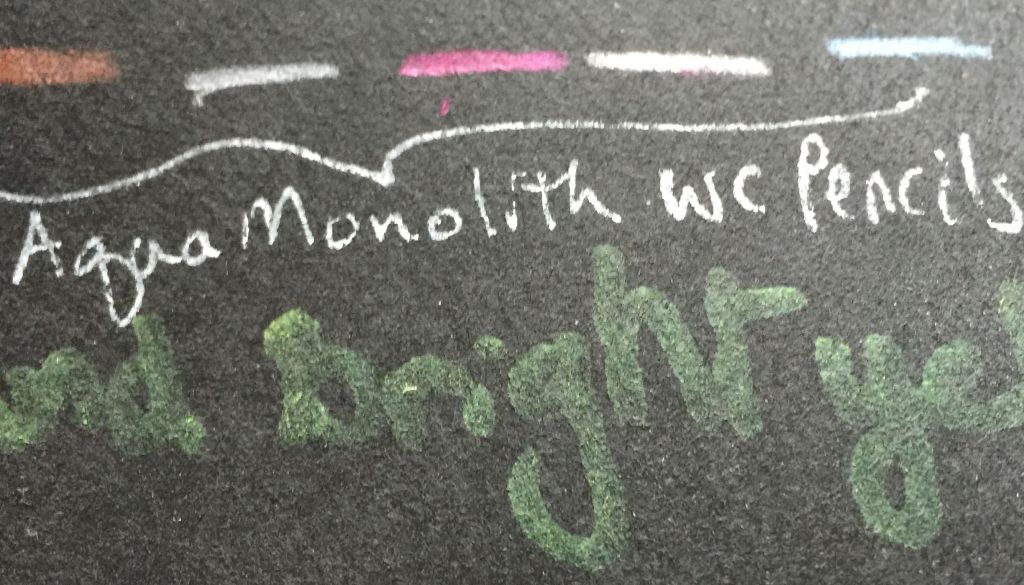
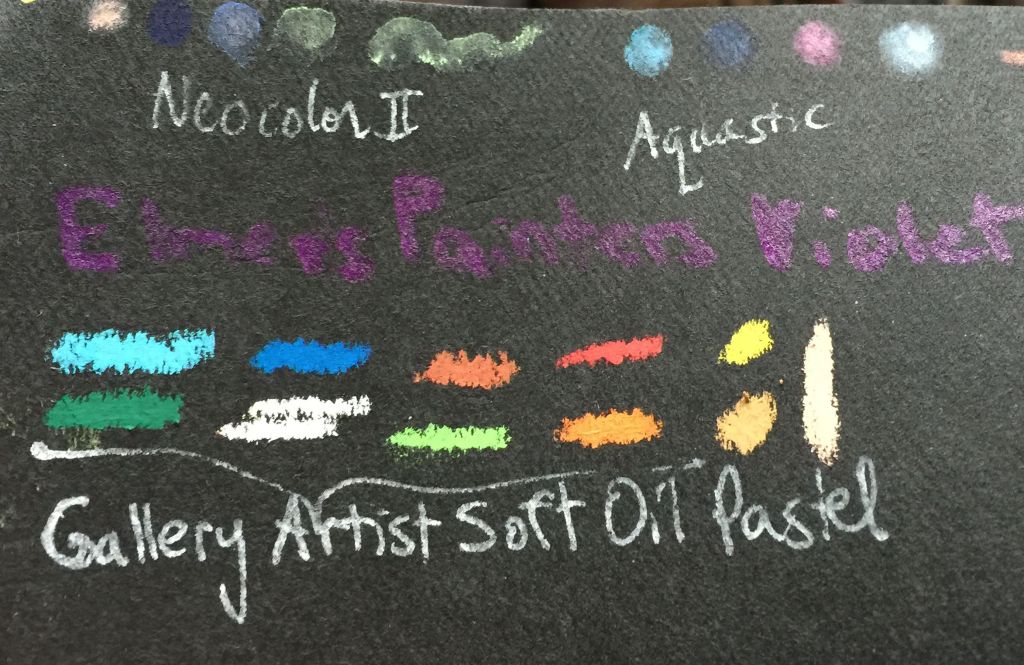
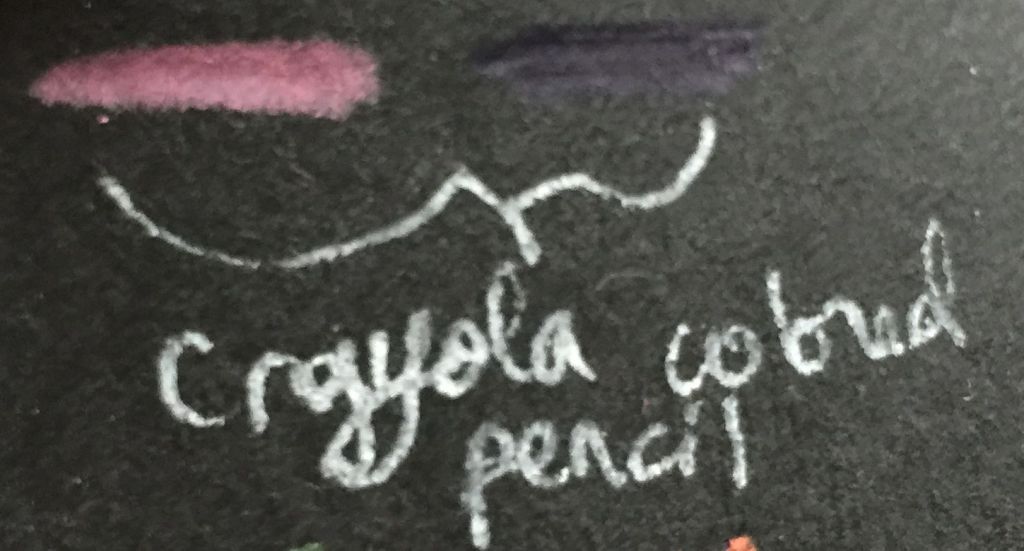


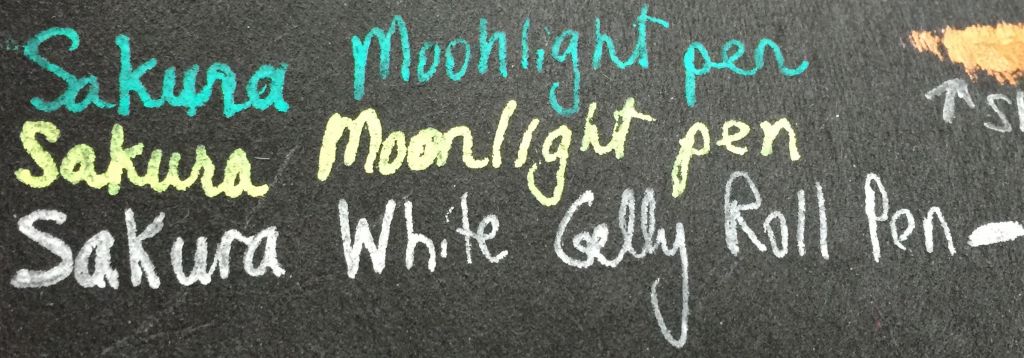
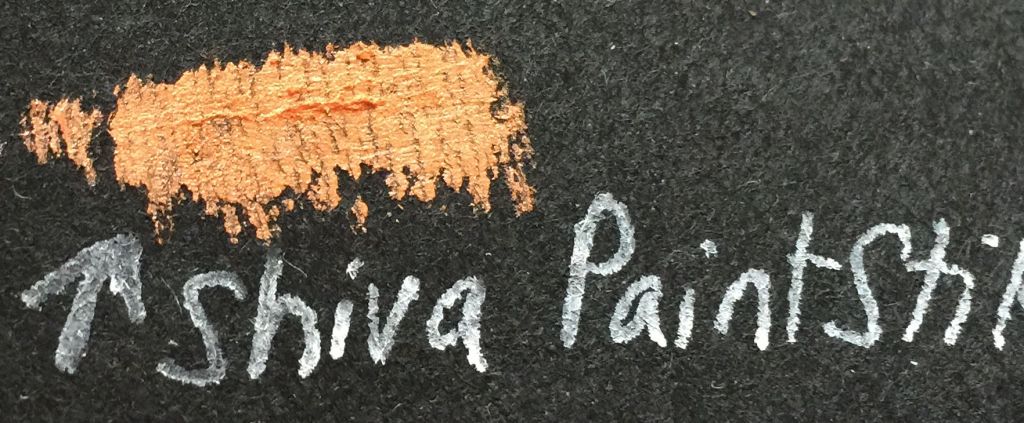
Sakura Gelly Roll Moonlight pens, Mungyo Artist Soft Oil Pastels, Uni-Posca paint pens , and only some fabric paints show very boldly when applied to black Kraft-tex. Some colors of watercolor pencil (Cretacolor’s AquaMonolith) and colored pencil show very well to rather decently. Test first. Generally Best Performers: Sakura Gelly Roll Moonlight pens, Neopaque paints, the shimmery kind of Shiva Paintstiks Uni-Posca paint pens would be fabulous for some projects but not others (it depends what you’re project is used for, subjected to). Sakura Gelly Roll Moonlight pens don’t have to be heat set or covered with an acrylic matt medium or anything like that — they are very water resistant and dry relatively fast. Mungyo Artist Soft Oil Pastels can not be heat set or sealed using an acrylic matt medium. They never cure and remain very to somewhat smudgeable. It remains to be seen whether any spray sealant would be suitable enough to allow these oil pastels to be used on wearables or anythign that might see some wear and tear. They are between student and artist grade quality (some colors are fugative). I have to test how Uni-Posca paint pens would stand moisture and/or wear. If needed, I’ll experiment with different says to fix these so they can be used for wearables or items that may be handled frequently enough. The watersoluble oil pastels showed better if I wetted the Kraft-tex and then applied one to numerous times. They can be fixed in the manner described earlier on this page. More testing to follow…
Upcoming
- Washability — Always test washability of various artwork on the Kraft-tex. The Kraft-tex itself is very washable.
- Printing on Kraft-tex — I will test clear Golden Digital Grounds on white Kraft-tex. I have that already and am unsure if I want to by TAP (transfer artists paper) too.
- Testing Opacity on Black Kraft-tex — More testing!
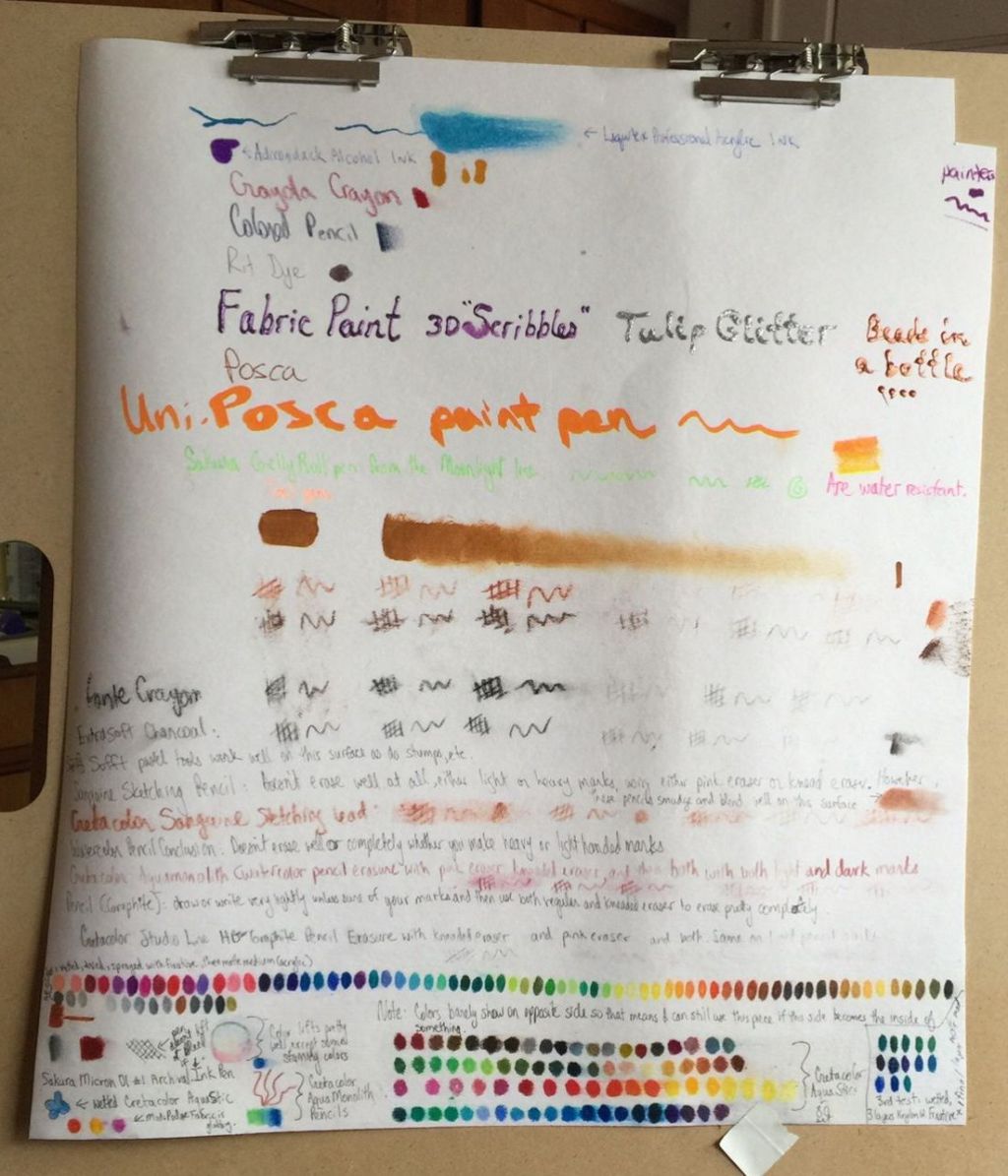
Leave a comment